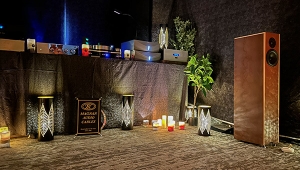| Columns Retired Columns & Blogs |
Listening #13
When some people record music, they make an effort to record the ambient sound of the hall or other performing space along with it. On the other side of the coin, some engineers work to capture only the sounds of the performers, so the recordings they make sound comparatively dry. And, of course, there are engineers who don't make an effort one way or the other, and whose work contains whatever hall sound does or does not come their way by accident.
The libraries and private collections of the world are filled with great recordings—masterpieces, in some instances—that were made in all the various ways described above.
Now let's switch gears and think about loudspeakers. Some are made to give the listener only what's on (one channel of) a recording. Others use, say, a rear-firing tweeter to give the spatial component of music playback a little pizzazz. And others still go thoroughly batshit in this regard, with drivers aimed every which way in an effort to "reproduce" the "true sound" of the "concert hall." (My overuse of quotation marks is meant to imply, of course, the misguidedness of such notions.)
Did I say loudspeakers? Now that I think about it, why stop there? Let's talk about entire systems. Let's talk about surround sound (pace Kal Rubinson). Some systems are made to present the home listener with only the material on the recording, the way the microphones heard it in the first place. Some systems are made to use additional amplifiers and loudspeakers to "reproduce" the "true sound" of...you know where I'm going.
What I want to know, Mister Death, is this: What happens when you play a reverberantly recorded piece of music through a loudspeaker or a system that was itself designed to add a reverberant effect? Or: What happens when you play a recording made with reverberation scheme A on a system designed to add reverberation scheme B? Or: What happens when you play back a dryly recorded orchestra on a system or loudspeakers designed to add only a tiny, chamber-music-sized dollop of room sound?
For once, I can answer my own stupid question. It might sound good or it might sound bad; your opinion of how it sounds might change over time, or even from day to day. But if you get something out of it—if the music moves you and connects with you in some otherwise indescribable physical, emotional, or even spiritual way—then it's good.
The end. Finis. That's all I really had to say.
The pursuit of unhappiness
The above is only one of the many, many reasons I say that real music and hi-fi have nothing to do with one another. They are different experiences. Wishing they weren't different is understandable and perhaps even noble, but pointless. Wishing won't make it so.
It won't make it so because, no matter what "philosophy" informs your hi-fi system, that system will do what you want it to do with only a relatively small percentage of the recordings in your collection—unless, of course, your collection is very tiny and very limited to well-recorded performances of...well, I guess it might actually work for an audiophile, after all. But for everyone else, the pursuit of fidelity is pointless—so you might as well just have fun with that multi-thousand-dollar rack of toys filling one end of your room.
Some readers, of course, will sniff indignantly (as if there were any other way to sniff): It's bad attitudes like mine that keep our industry from adopting the guidelines that could correct all this.
Guidelines? Yes, by all means—let's pass a law, by which any architect or contractor who aspires to create a museum must abide: Paintings and photographs must be centered at a certain height. Light must be a certain intensity, in lumens—no more, no less. People must be forced to sit a certain distance from each work of art, no more, no less.
Sound stupid? There's a good reason for that: It is.
Any attempt to define the way in which humans must interact with works of art is a foolish, venal thing, and doubtless the product of an intolerant and unhappy mind. For philistines like me to reject those guidelines—any guidelines—is not, as some would try to frame the argument, a matter of trying to paint a moustache on the Mona Lisa; rather, it's a matter of saying that no one has the right to tell me how far to stand from it. (I remain free to imagine a moustache on it.)
Forcing people to appreciate the recorded arts in any way—mine, yours, anyone's—is just as wrong. Maybe more so, depending on how good or bad your hi-fi sounds.
The pursuit of unhappiness is constitutionally guaranteed, and you're free to go after it in any way you see fit. Go ahead and sink all your money into whatever it is that baits your hook or frosts your cupcake: A whole roomful of speakers. A 10-channel amplifier to go with your 10-gallon hat. A processor that you and I both know will be obsolete before the ink has even begun to dry on this page.
You are not free, however, to force your vision of unhappiness on everyone else ("unless, of course, they ask you," as Andy Partridge sings in "The Garden of Earthly Delights"). History suggests that a few of you will try to do that anyway, and because every playground has its suckups as well as its bullies, you'll probably succeed a small part of the time—enough to make you start to believe in your own goo-roo-vity. Go ahead...
- Log in or register to post comments




































